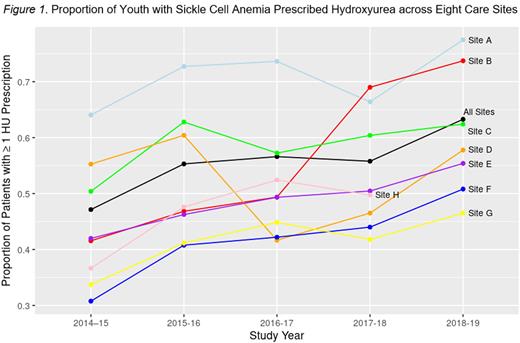Abstract
Introduction: Youth with sickle cell anemia (SCA) are at risk for significant morbidity and mortality and impaired quality of life. Hydroxyurea (HU) is one of few disease-modifying therapies for SCA, with strong evidence of efficacy and safety. In 2014, the National Heart, Lung, and Blood Institute (NHLBI) published guidelines advocating that HU be offered to all youth with SCA (HbSS and HbSβ0-thalassemia genotypes) ages >9 months, regardless of clinical severity. We sought to examine hydroxyurea use among youth with SCA in the five years following the release of this clinical practice guideline across eight pediatric sickle cell care centers nationally.
Methods: Retrospective data from 2014-2019 were obtained from PEDSnet, a network of pediatric health systems within the United States. A base cohort of sickle cell disease patients who received care at any time across the eight health systems was identified using a validated computable phenotype (Michalik et al., 2017). Next, patients with HbSS genotype were identified via diagnosis codes assigned at Hematology/Oncology outpatient visits. Finally, the proportion of youth with SCA (HbSS genotype) ages 9 months to 21 years who received >1 HU prescription was calculated for each sickle cell care center for each year. We selected >1 HU prescriptions within a study year as an indicator that the patient/family agreed to initiate or continue this therapy. Patients who had <1 Hematology/Oncology outpatient visit during the study year and those likely receiving chronic transfusion therapy (defined as >7 blood transfusion procedures during the study year) were excluded.
Results: Between 1340 and 1601 patients per year met selection criteria and were included in this analysis; data were missing from one site for the final study year (2018-19). Most centers demonstrated a trend of increasing HU prescription rates over the study period. There was significant variability between sites in the proportion of youth with SCA who received >1 HU prescription within each study year: 31% - 64% (2014-15), 41% - 73% (2015-16), 42% - 74% (2016-17), 42% - 69% (2017-18), and 47% - 77% (2018-19; see Figure 1).
Conclusions: Despite national guidelines and decades of strong evidence of efficacy and safety, use of HU is suboptimal among patients with SCA. Varying HU prescribing practices across clinicians and sites (e.g., length of supply provided) and lack of pharmacy dispensing data limited our ability to examine maintenance of HU therapy over time within this analysis. Additional research is needed to examine clinical implementation processes that may contribute to high variability in HU uptake across sickle cell care centers. Evidence-based interventions to improve scale up of HU are critical for this high-risk population.
Acknowledgements: The research reported in this abstract was conducted using PEDSnet, A National Pediatric Learning Health System, and includes data from the following PEDSnet institutions: Children's Hospital Colorado, Children's Hospital of Philadelphia, Cincinnati Children's Hospital Medical Center, Nationwide Children's Hospital, Nemours Children's Health, Seattle Children's Hospital, and St. Louis Children's Hospital.
Disclosures
Hulbert:Pfizer: Other: Spouse's employment; GBT: Consultancy, Research Funding; Forma therapeutics: Research Funding; Bluebird bio: Consultancy. Crosby:Forma Therapeutics: Consultancy, Honoraria, Other: Grant reviews; Global Blood Therapeutics: Honoraria.
Author notes
Asterisk with author names denotes non-ASH members.


This feature is available to Subscribers Only
Sign In or Create an Account Close Modal